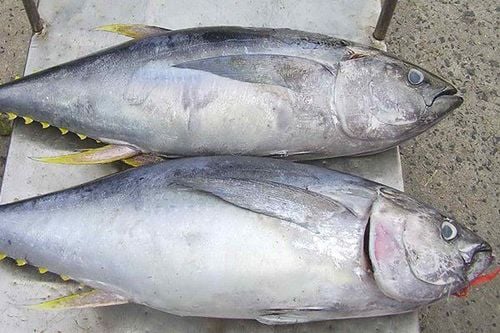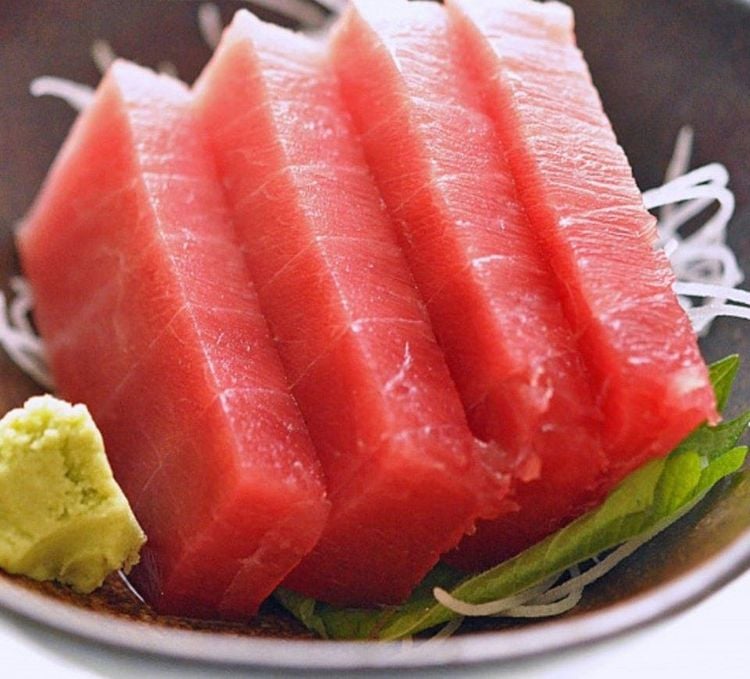Tuna is a popular fish enjoyed worldwide. Many restaurants prepare fresh tuna into delicious dishes that attract diners. However, consuming raw tuna improperly can lead to various health issues.
1. Learn about tuna and its nutritional components.
1.1. Origin
Tuna is a type of seafood found in environments ranging from the Atlantic Ocean to Indonesia. The most commonly known species of tuna in the United States are Skipjack (light tuna) and Albacore (white tuna).
1.2. Nutritional Components
Tuna is rich in vitamin D, which helps boost the immune system, protect bones, and prevent osteoporosis. Additionally, tuna contains other important vitamins and minerals such as vitamin B6, potassium, selenium, and iodine.
In a 113g serving of tuna, you can find:
- Calories: 145
- Protein: 26.77 grams
- Fat: 3.37 grams
- Carbohydrates: 0 grams
- Fiber: 0 grams
- Sugar: 0 grams

2. Health Benefits of Eating Tuna
2.1. Reducing the Risk of Heart Disease
The high levels of omega-3 fatty acids in tuna can help lower omega-6 fatty acids and LDL cholesterol buildup in the arteries. Many studies have shown that increased omega-3 intake can reduce the incidence of cardiovascular diseases, including heart attacks and strokes.
2.2. Preventing Eye Disorders
The omega-3 content in tuna offers several benefits for eye function. Women who consume more tuna weekly can reduce their risk of dry eye disease by up to 68%. This nutrient is also believed to slow the growth of tumor cells and reduce inflammation in the body.
2.3. Supporting Weight Loss
Tuna is an essential food in many diets. It is a type of white meat that is relatively high in protein but low in calories. Consequently, it helps you feel fuller for longer and can reduce overall food intake.

3. Is Eating Raw Tuna Healthy?
Raw tuna is commonly prepared in dishes such as salads, sushi, and sashimi, which are popular and beloved in many countries around the world. However, many people wonder whether eating raw tuna is safe. Health experts have outlined several risks associated with consuming raw tuna:
3.1. Presence of Parasites
Despite its nutritional benefits, improperly prepared raw tuna can pose certain risks. Tuna may harbor various parasites, such as Opisthorchiidae and Anisakidae which can cause illnesses like intestinal infections, diarrhea, vomiting, and fever.
A study revealed that 64% of Pacific bluefin tuna samples sourced from Japanese waters were infected with Kudoa hexapunctata, a parasite linked to diarrhea in humans. Additionally, samples of bluefin and yellowfin tuna from the Pacific contain Kudoa parasites that can lead to food poisoning.
Moreover, up to 89% of tuna from the offshore waters of Iran have been found to be infected with parasites that can attach to the human stomach and intestines, causing anisakiasis. Symptoms of this condition include bloody stools, vomiting, and stomach pain.
Eating raw tuna increases the risk of parasitic infections. Most parasites can be killed by cooking or freezing the fish.

3.2. High Mercury Levels
Mercury is a heavy metal that can accumulate in the human body through diet and indirect exposure. Tuna, especially larger species like Albacore, Yellowfin, Bluefin, and Bigeye tuna, can contain high levels of mercury. Most raw tuna used in dishes such as steaks, sushi, and sashimi comes from these species.
Consuming excessive amounts of raw tuna can lead to significant mercury accumulation in the body, resulting in serious health issues, including brain and heart damage.
3.3. Increased Risk of Salmonella Infection
Many individuals who contract Salmonella after eating tuna experience symptoms such as diarrhea, fever, and abdominal cramps within 12 to 72 hours. The illness typically lasts from 4 to 7 days and often resolves without treatment.
Given these risks, certain groups should limit their raw tuna consumption, including:
- Pregnant and breastfeeding women
- Children
- Older adults
- Individuals with weakened immune systems
- Cancer patients undergoing treatment
Even healthy individuals should consume tuna within recommended limits to avoid potential risks. Most types of tuna can exceed the daily mercury consumption limit set by health authorities in the U.S. and other countries. Adults should aim to eat 85–140 grams of tuna 2–3 times a week to obtain sufficient omega-3 fatty acids. Alternative fish recommended to avoid high mercury levels include salmon, crab, and cod

4. Eating Tuna Safely and Correctly
Cooking tuna is the best way to eliminate parasites and reduce the risk of foodborne illnesses. However, it is still possible to eat raw tuna safely. The Food and Drug Administration (FDA) recommends freezing raw tuna using one of the following methods to kill parasites:
- Freeze at -20 °C (or lower) for 7 days.
- Freeze at -35 °C (or lower), then keep it at -35 °C or lower for 15 hours.
- Freeze at -35 °C (or lower), then store the tuna at -20 °C or lower for 24 hours.
Raw frozen tuna should be thawed in the refrigerator before consumption. Following these methods can effectively kill most parasites in tuna.
Tuna is a nutrient-rich food; however, it also contains significant levels of mercury and parasites. Therefore, certain individuals should exercise caution when consuming raw tuna and ensure they eat it safely to avoid food poisoning.
Please dial HOTLINE for more information or register for an appointment HERE. Download MyVinmec app to make appointments faster and to manage your bookings easily.
References: healthline.com, webmd.com
To arrange an appointment, please call HOTLINE or make your reservation directly HERE. You may also download the MyVinmec app to schedule appointments faster and manage your reservations more conveniently.








